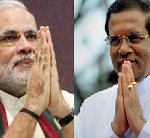It is no secret that much of India’s diplomatic capital is spent on its very challenging neighbourhood, where even friendly states, more than often, give New Delhi a run for its money—as was the case with India-Sri Lanka ties under the now-deposed government of former president Mahinda Rajapaksa.
Rajapaksa, who lost the presidential elections on January 8 and, surprisingly to some, peacefully gave up the seat of power in Colombo to his former aide and party defector Maithripala Sirisena, had a bittersweet relationship with New Delhi.
However, this is now expected to change, with India’s majority government led by Prime Minister Narendra Modi looking to give a big push to the India story abroad. In this context, Sirisena’s visit to India from February 15 will be an opportunity to reset the bilateral relationship.
A major part of why Sirisena’s victory was quietly welcomed by India was because of his willingness to check China’s rise in Sri Lanka. During his pre-election campaign, Sirisena said he will balance the unprecedented inroads, both political and economic, that Beijing had managed to make under Rajapaksa.
New Delhi has welcomed Sirisena’s views on China, and India hopes to reinvigorate its relations—which were often challenging when Rajapaksa was in power—with the Sri Lankan government, and address bilateral friction on crucial matters such as the hounding of Indian fishermen by the Sri Lankan navy, the docking of Chinese naval vessels in the country’s ports, and the issue of Sri Lankan Tamils in the north.
Meanwhile, Beijing has shifted its purview beyond its immediate coastline and the South China Sea. In fact, it now views the Indian Ocean, traditionally India’s area of influence, as a region where China can orchestrate its own counter-balance. For this, it is looking to woo countries such as Sri Lanka, Burma, and Bangladesh.
Sirisena’s anti-China statements prior to the polls had led some Indian strategic thinkers to hope that this could be a turning point for India-Sri Lanka ties. However, such an expectation was perhaps unrealistic. The new government has already decided to move forward with the Chinese-funded port-city project in the southern coastal town of Hambantota, despite previously suggesting that it will reassess the deal. Millions of Chinese dollars have also been invested in other projects in the country—including in the $1.4 billion Colombo port, which too has now reportedly got the go-ahead.
Even as India continues to hope that the new Sri Lankan government will provide checks on China’s expansion, particularly on its ports hosting Chinese naval vessels, it is in New Delhi’s interest to now bolster its own trade ties with Sri Lanka as a counter to China.
The Indian government must also help to build the economies of its neighbouring countries in order to create confidence along its borders. While China has the capability to infuse large sums of capital into countries it thinks will help strengthen its influence zones, India’s approach tends to be partnership-based investments and development programmes. The Development Partnership Administration (DPA) of the Ministry of External Affairs, an international aid agency, works on this model, instead of just dumping funds in projects. The DPA has championed rehabilitation projects in Sri Lanka’s north after the civil war ended in 2009. This approach is more likely to succeed in the long term, especially with neighbours such as Sri Lanka
In terms of security, even if the U.S. believes that India can be a regional security provider—which means a counter to China for the West—as the U.S. government has suggested in its national security strategy document released on February 6, New Delhi must not forget that its smaller neighbours cannot be seen as mere entities for geopolitical manoeuvring in the Indian Ocean.
Along with this, India also must stop thinking, specifically in public discourse, of countries such as Sri Lanka as its “backyard”—a term that is perceived as derogatory by its neighbours, rather than as an expression of India’s regional clout.
While addressing the Sixth Annual Heads of Mission Conference at Rashtrapati Bhavan on February 8, President Pranab Mukherjee said the momentum must remain vibrant between India and its neighbourhood—and it must build on Prime Minister Narendra Modi’s invitation to all SAARC leaders for his swearing-in ceremony in May 2014.
Now, with Sirisena scheduled to visit India from February 15 on the invitation of President Mukherjee, India can offer its unconditional hand in partnership to Colombo. Even while pursuing its own national security interests in Sri Lanka, New Delhi must offer enough so that Colombo too stands to gain from partnering to secure India’s larger security and economic policies.
Kabir Taneja is a journalist and researcher who specialises in foreign affairs and energy security. His columns have been published in the New York Times, The Diplomat and Huffington Post.
This article was exclusively written for Gateway House: Indian Council on Global Relations. You can read more exclusive content here.
For interview requests with the author, or for permission to republish, please contact outreach@gatewayhouse.in.
© Copyright 2015 Gateway House: Indian Council on Global Relations. All rights reserved. Any unauthorized copying or reproduction is strictly prohibited


